Monday, January 02, 2006
Making Venezuela proud
Many people who have not been to Venezuela may have the false impression that its capital, Caracas, is a coastal city. It isn’t. It is a pseudo costal city at best. It is actually located less than 10 miles from the ocean as the crow flies. But even that overstates how close Caracas is to the sea. The reason for that is that between Caracas and the ocean there is a large mountain chain which is essentially where the Andes mountains that form the spine of South America end. These mountains, know as “El Avila”, top out at around 7,000 feet and almost completely cut Caracas off from the sea. Further, Caracas itself is in a valley at an altitude of about 3,000 which was key in providing for a more moderate climate less prone to tropical disease.

Skyscrapers of downtown Caracas (with very tacky advertisements) with the Avila in the background. On the other side of the mountains lies the Caribbean Sea.
But what Caracas’s location gave in terms of a favorable climate it took away in terms of ease of transport. To get from the coast to the city required an arduous and lengthy trip through the mountains. In the 1950s the trip was greatly eased when a modern 4 lane highway was built between La Guaira on the coast and Caracas. The highway, called the Caracas-La Guaira highway, is truly an engineering marvel. It winds its way through steep valleys, crosses deep ravines, and when necessary tunnels directly through mountains. All of this is done through terrain that is very rugged. The mountain and ravine walls are very steep and jagged reflecting the youth of these mountains – they are much more rugged than anything people in eastern North America will be used to.
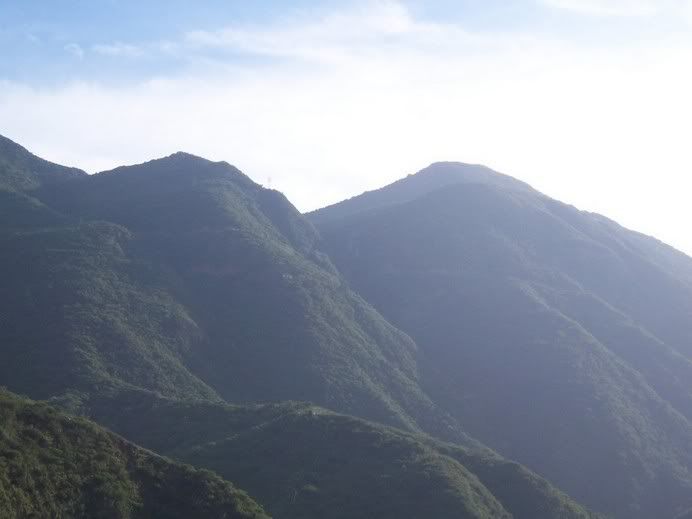
Some of the rugged mountains that the Caracas- Guaira highway traverses.
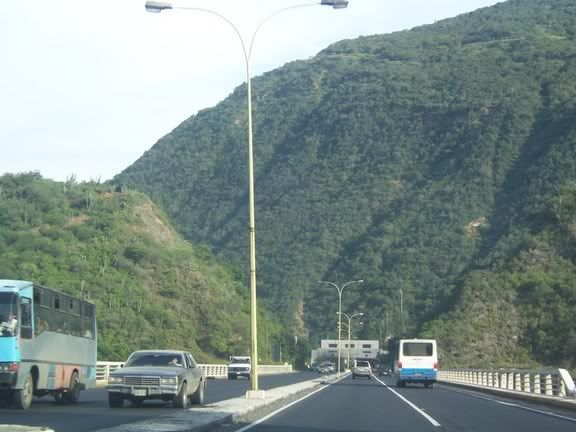
In this case the only path is to tunnel straight through a rather massive mountain
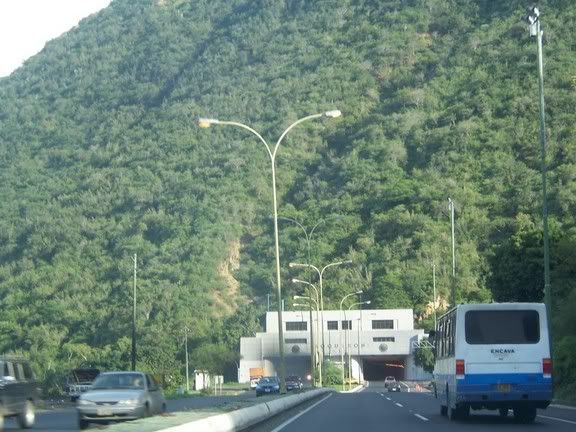
However, the ruggedness of the terrain not only created problems in the construction of the highway but also for its maintenance. As you can imagine combining these steep mountains with the heavy rains that frequent Caracas is a recipe for landslides. This is precisely what happened in 1999 when rain induced landslides killed thousands along the north face of El Avila.
Now the movement of land is taking its toll on the Caracas-La Guira highway. Specifically, one very long viaduct that crosses a deep ravine known as Viaduct #1 is being threatened with collapse. I will use the following graphic from Ultimas Noticias to show what is happening:
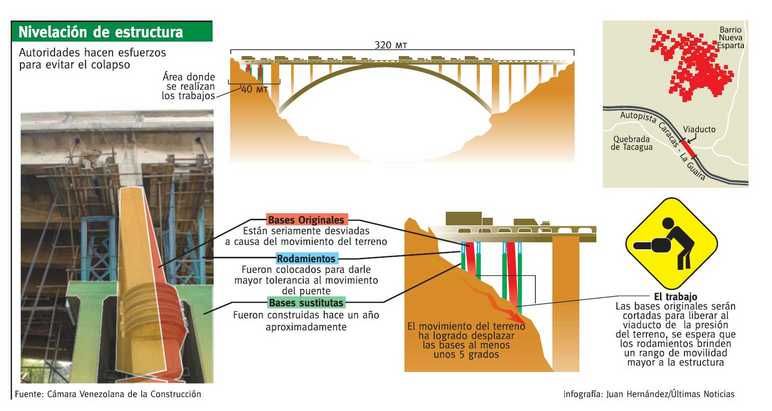
The top center picture shows what the viaduct looks like from the side. It is an arched concrete structure spanning a ravine that is about a thousand feet long and, I’ve been told, about 500 feet deep.
The fundamental problem is that the earth on the south side of viaduct is sliding down the ravine and taking the viaduct supports with it. However, the land isn’t moving straight down. It is also moving to the side. So the supports are being moved in two directions, one is toward the middle of the span which is compressing the viaduct and creating a prominent upward bulge in its center. The other lateral movement is pushing the viaduct off its axis to the side. Both these movements, if they continue, threaten the viaduct with collapse.
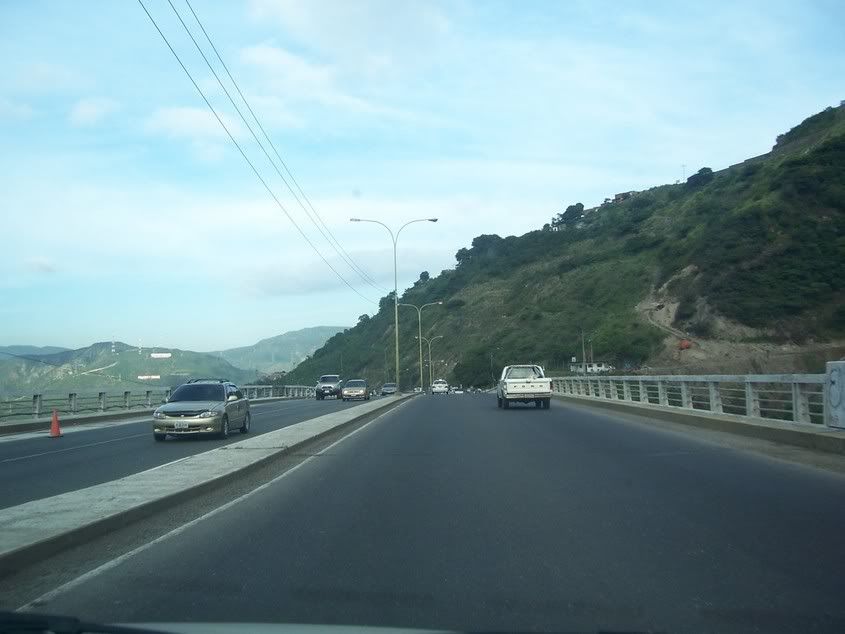
This is a picture taken while crossing Viaduct #1. If you look closely you can see that the center span is buckling upwards with the taxi straight ahead being at its apex
These movements have actually been going on for some time now (they were first noticed in the 1980s) and due to their potential seriousness have been monitored closely by the Venezuelan authorities. Of late the late the situation has become much more serious as the rate of movement of the land, and hence the viaduct supports, has accelerated. Where once the movement was measured in millimeters per week now it is centimeters. At that rate it was calculated that the viaduct would collapse within weeks. This would be disastrous for Caracas, cutting it off from the coast, its port, and from Venezuela’s principle international airport. There are alternate routes that could be used but they are not at all capable of handling the amount of traffic that the highway does, and they are generally much longer and more dangerous routes. Worse still, they are in state of disrepair and would take weeks or months of work to be made ready for traffic. So finding a way to avert the collapse of the viaduct #1 took on a great deal of urgency.
The engineers of the Venezuelan Infrastructure Ministry and their private contractors came up with an ingenious and novel solution. To prevent the supports that are being pushed down the ravine from pulling down the whole viaduct with them the decision was made to build replacement supports and then completely sever the original concrete supporting pillars.
Referring back to the Ultimas Noticias diagram they have a picture of the supports on the left and a schematic diagram of them on the right. The original supports are in red and looking at the photo one can see how far they have been displaced (the superimposed orange graphic shows what their original position was). The picture also shows the replacement supports with the bottom part of them being a concrete base (in green) and the top part of them being a metal scaffolding (in blue) that reaches up to the roadway. Why the substitute concrete base was not built all the way up to the roadway will be apparent shortly.
With the substitute supports in place by mid-December the original supports, the ones sliding down the ravine, were completely cut so that they are no longer supporting the viaduct and are no longer putting dangerous pressures on it. One of the more amazing aspects of this is that the viaduct has remained in operation during all of this. It has rarely been shut down for more than 20 minutes during particularly delicate parts of the work. This really is the civil engineering equivalent of open heart surgery. But the severing of the old supports is only half the story. To give the other half of the story I need to show another Ultimas Noticias graphic:
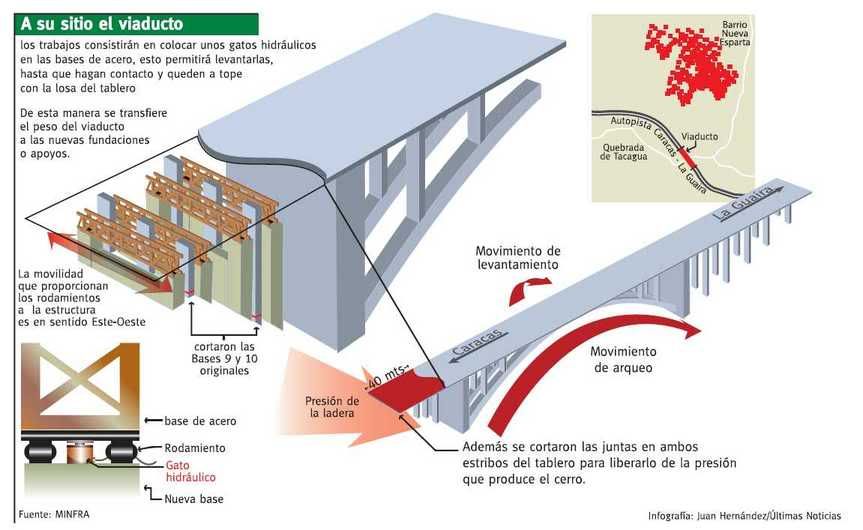
In the top part of the graphic we again see the original structure (bluish-grey) the new concrete supports (brownish-grey) and the steel supports (brown) on top of the new concrete supports. In the bottom left of the graphic we see why there are two parts to the new supports. To save the viaduct it isn’t simply enough to stop its movement. It was already so far out of position that it was under tremendous stress which put it in risk of failure. So not only did the moving supports need to be cut but also a way needed to be found to move the viaduct at least part way back to its original position.
To accomplish this the metal part of the new supports doesn’t directly lay on the concrete base but instead on steel rollers. As is also shown in the graphic they have position hydraulic jacks on the concrete base and intend to push the metal part of the supports, and the roadway along with it, back into its original position or at least as far as possible. This was actually begun right before the Christmas holiday and has proven more difficult than was anticipated. They only managed to move it a few centimeters before taking a break for the holidays. Due to the difficulties in moving it with the hydraulic jacks they were talking about bring in heavy lift helicopters with slings to pull the viaduct into position!!
So this is very much still a work in progress and the work is set to resume on January 3rd. Lets hope that the rest of the work goes as well as it has up to this point (I sure hope this post doesn’t jinx anything). What’s more, this is only a temporary solution. After all, the new supports will eventually begin sliding down the ravine too. The engineers’ estimate that what they are doing is giving the viaduct an additional 300 days of use by which time alternate routes can hopefully be prepared. But needless to say, following the day to day work on the viaduct with all the potential risks has been both suspenseful and amazing. Some day I expect to see a Discovery Channel special on this – it really is that dramatic and unique.
Finally there are some other comments that really need to be made here. The first is that to the best of my knowledge this is an entirely Venezuelan operation. In all that I have read about it I have never heard any reference made to foreign involvement in any of the work or even consulting. Venezuelans unfortunately often suffer from the notion that what is Venezuelan is inherently inferior and what comes from abroad is better. Yet what is taking place with the Viaduct #1 is world class engineering which if successfully completed will probably be studied by civil engineers for years. This should clearly show that technical competence is not solely the province of those from northern latitudes.
Maybe even more importantly, although the Venezuelan opposition media often comes across as hoping the viaduct collapses just to embarrass the Chavez government, the people carrying out the work aren’t showing their political colors – only their engineering excellence. Given that most of the people are involved are private contractors it wouldn’t surprise me to find out that many of them oppose Chavez. But quite frankly I couldn’t care less what their political tendencies are just as I had no use for the debate about whether Ozzie Guillen was a Chavista or not. It just really doesn’t matter. It is often lost amongst all the hot air that politics isn’t a sport were we sit around and rout for “our” side to win. What politics is supposed to be about is making peoples lives better. The workers and engineers fighting to save the Viaduct #1 are not only making Venezuela better with their hard work and ingenuity – they should also be making Venezuelans very, very proud.
|

Skyscrapers of downtown Caracas (with very tacky advertisements) with the Avila in the background. On the other side of the mountains lies the Caribbean Sea.
But what Caracas’s location gave in terms of a favorable climate it took away in terms of ease of transport. To get from the coast to the city required an arduous and lengthy trip through the mountains. In the 1950s the trip was greatly eased when a modern 4 lane highway was built between La Guaira on the coast and Caracas. The highway, called the Caracas-La Guaira highway, is truly an engineering marvel. It winds its way through steep valleys, crosses deep ravines, and when necessary tunnels directly through mountains. All of this is done through terrain that is very rugged. The mountain and ravine walls are very steep and jagged reflecting the youth of these mountains – they are much more rugged than anything people in eastern North America will be used to.

Some of the rugged mountains that the Caracas- Guaira highway traverses.

In this case the only path is to tunnel straight through a rather massive mountain

However, the ruggedness of the terrain not only created problems in the construction of the highway but also for its maintenance. As you can imagine combining these steep mountains with the heavy rains that frequent Caracas is a recipe for landslides. This is precisely what happened in 1999 when rain induced landslides killed thousands along the north face of El Avila.
Now the movement of land is taking its toll on the Caracas-La Guira highway. Specifically, one very long viaduct that crosses a deep ravine known as Viaduct #1 is being threatened with collapse. I will use the following graphic from Ultimas Noticias to show what is happening:

The top center picture shows what the viaduct looks like from the side. It is an arched concrete structure spanning a ravine that is about a thousand feet long and, I’ve been told, about 500 feet deep.
The fundamental problem is that the earth on the south side of viaduct is sliding down the ravine and taking the viaduct supports with it. However, the land isn’t moving straight down. It is also moving to the side. So the supports are being moved in two directions, one is toward the middle of the span which is compressing the viaduct and creating a prominent upward bulge in its center. The other lateral movement is pushing the viaduct off its axis to the side. Both these movements, if they continue, threaten the viaduct with collapse.

This is a picture taken while crossing Viaduct #1. If you look closely you can see that the center span is buckling upwards with the taxi straight ahead being at its apex
These movements have actually been going on for some time now (they were first noticed in the 1980s) and due to their potential seriousness have been monitored closely by the Venezuelan authorities. Of late the late the situation has become much more serious as the rate of movement of the land, and hence the viaduct supports, has accelerated. Where once the movement was measured in millimeters per week now it is centimeters. At that rate it was calculated that the viaduct would collapse within weeks. This would be disastrous for Caracas, cutting it off from the coast, its port, and from Venezuela’s principle international airport. There are alternate routes that could be used but they are not at all capable of handling the amount of traffic that the highway does, and they are generally much longer and more dangerous routes. Worse still, they are in state of disrepair and would take weeks or months of work to be made ready for traffic. So finding a way to avert the collapse of the viaduct #1 took on a great deal of urgency.
The engineers of the Venezuelan Infrastructure Ministry and their private contractors came up with an ingenious and novel solution. To prevent the supports that are being pushed down the ravine from pulling down the whole viaduct with them the decision was made to build replacement supports and then completely sever the original concrete supporting pillars.
Referring back to the Ultimas Noticias diagram they have a picture of the supports on the left and a schematic diagram of them on the right. The original supports are in red and looking at the photo one can see how far they have been displaced (the superimposed orange graphic shows what their original position was). The picture also shows the replacement supports with the bottom part of them being a concrete base (in green) and the top part of them being a metal scaffolding (in blue) that reaches up to the roadway. Why the substitute concrete base was not built all the way up to the roadway will be apparent shortly.
With the substitute supports in place by mid-December the original supports, the ones sliding down the ravine, were completely cut so that they are no longer supporting the viaduct and are no longer putting dangerous pressures on it. One of the more amazing aspects of this is that the viaduct has remained in operation during all of this. It has rarely been shut down for more than 20 minutes during particularly delicate parts of the work. This really is the civil engineering equivalent of open heart surgery. But the severing of the old supports is only half the story. To give the other half of the story I need to show another Ultimas Noticias graphic:

In the top part of the graphic we again see the original structure (bluish-grey) the new concrete supports (brownish-grey) and the steel supports (brown) on top of the new concrete supports. In the bottom left of the graphic we see why there are two parts to the new supports. To save the viaduct it isn’t simply enough to stop its movement. It was already so far out of position that it was under tremendous stress which put it in risk of failure. So not only did the moving supports need to be cut but also a way needed to be found to move the viaduct at least part way back to its original position.
To accomplish this the metal part of the new supports doesn’t directly lay on the concrete base but instead on steel rollers. As is also shown in the graphic they have position hydraulic jacks on the concrete base and intend to push the metal part of the supports, and the roadway along with it, back into its original position or at least as far as possible. This was actually begun right before the Christmas holiday and has proven more difficult than was anticipated. They only managed to move it a few centimeters before taking a break for the holidays. Due to the difficulties in moving it with the hydraulic jacks they were talking about bring in heavy lift helicopters with slings to pull the viaduct into position!!
So this is very much still a work in progress and the work is set to resume on January 3rd. Lets hope that the rest of the work goes as well as it has up to this point (I sure hope this post doesn’t jinx anything). What’s more, this is only a temporary solution. After all, the new supports will eventually begin sliding down the ravine too. The engineers’ estimate that what they are doing is giving the viaduct an additional 300 days of use by which time alternate routes can hopefully be prepared. But needless to say, following the day to day work on the viaduct with all the potential risks has been both suspenseful and amazing. Some day I expect to see a Discovery Channel special on this – it really is that dramatic and unique.
Finally there are some other comments that really need to be made here. The first is that to the best of my knowledge this is an entirely Venezuelan operation. In all that I have read about it I have never heard any reference made to foreign involvement in any of the work or even consulting. Venezuelans unfortunately often suffer from the notion that what is Venezuelan is inherently inferior and what comes from abroad is better. Yet what is taking place with the Viaduct #1 is world class engineering which if successfully completed will probably be studied by civil engineers for years. This should clearly show that technical competence is not solely the province of those from northern latitudes.
Maybe even more importantly, although the Venezuelan opposition media often comes across as hoping the viaduct collapses just to embarrass the Chavez government, the people carrying out the work aren’t showing their political colors – only their engineering excellence. Given that most of the people are involved are private contractors it wouldn’t surprise me to find out that many of them oppose Chavez. But quite frankly I couldn’t care less what their political tendencies are just as I had no use for the debate about whether Ozzie Guillen was a Chavista or not. It just really doesn’t matter. It is often lost amongst all the hot air that politics isn’t a sport were we sit around and rout for “our” side to win. What politics is supposed to be about is making peoples lives better. The workers and engineers fighting to save the Viaduct #1 are not only making Venezuela better with their hard work and ingenuity – they should also be making Venezuelans very, very proud.
|
